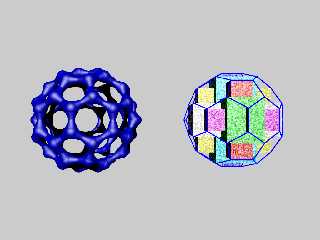|
 |
So, I hunted down a typo in one of my array definitions, and then figured out a
simple 3-line method for skipping 12 redundant vertices.
Since the entire molecule is sp2-hybridized, there are only 3 bonds to any atom.
It's also easy to just do a distance check to see where to connect atoms. So
the placement of all 90 cylinders in this scene is fully automated.
(thankin' my lucky stars ...)
So all of that takes 100 lines of code.
Of course, to adapt and paraphrase what someone once said about optimization, if
one method takes a week to write, and another method only takes a day to write,
but needs 6 days of research - then they're both equally efficient. :D
Aside from differences in orientation, my model looks identical to Thomas'.
I thought it would be interesting to visualize the permutations of the "basis
vertices" of the truncated icosahedron, and with 8 permutations of sign change,
that would give me the vertices of a cube for each basis vertex.
Each vertex has 3 vector components, with a total number of permutations
equaling factorial (3) = 6, and the even permutations is only half that, so
there are 3.
3 basis vertices x 3 permutations each = 9 "expanded basis vertices"
Each of these vertices just get moved around the signed permutations of the unit
vector, so I can just multiply each vertex by <-1, -1 -1> and <1, 1, 1> to get
the corners of each box {}
Using the color array from my permutations scene and adding rgb 0.5 to get a
ninth color let me assign each box a color using the index value of my loop.
Then I just use a pared-down copy of my atom-connecting loop to join the
vertices.
I'd like to get an even-permutation routine that I found working for SDL, and
also maybe find a way to highlight the symmetry groups. Perhaps then I can trim
down the structure to the smallest repeating unit and assemble the whole thing
with nothing but rotations of that one unit. Assigning a transform matrix to
orient the fullerene to any of the 4 basic views would be nice as well.
https://www.qfbox.info/4d/buckyball
I'm also NOT enamored by POV-Ray's blob function, and might see about working
out something with functions and an isosurface to see if I can get a smoother,
more pleasing result.
I don't see myself solving the Schrodinger equation for the hybridized orbitals
any time soon (<--- never), but maybe someone has a nice approximation function
posted somewhere.
- BW
Post a reply to this message
Attachments:
Download 'fullerene.png' (248 KB)
Preview of image 'fullerene.png'

|
 |




![]()